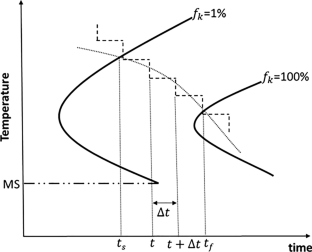Journal of Materials Engineering and Performance ( IF 2.3 ) Pub Date : 2024-04-15 , DOI: 10.1007/s11665-024-09443-1 Amirhossein Meysami , Goodarz Ahmadi , Alex Meisami

|
The direct quenching (DQ) process is essential not only for achieving the desired microstructure distribution in steel heat treatment but also for reducing energy consumption post-hot rolling. A comprehensive finite volume model (FVM) was developed to precisely describe the effects of direct quenching on the microstructural evolutions in AISI 4140 steel. The model incorporates diffusion-controlled and diffusionless transformations, with the cooling curve discretized into small isothermal steps using tailored time-temperature-transformation (TTT) diagrams. The Johnson-Mehl-Avrami-Kolmogorov (JMAK) kinetic equation, and Scheil’s additive rule were used to describe diffusion-controlled transformations, while Koistinen and Marburger’s equation was employed to model diffusionless transformation. The model predicted volume fractions and microstructure evolution of ferrite, pearlite, bainite, martensite, and retained austenite. Experimental validation was performed using a physical model on AISI 4140 steel. Magnetization and XRD methods were used to measure volume fractions of retained austenite, ferrite, bainite, and martensite. The comparison between the measured retained austenite volume fraction using the magnetization method and the total volume fractions of ferrite, bainite, and martensite using XRD along the billet radius with predicted data showed a good agreement. The observed deviation, which is less than 10% between simulated and measured data, confirmed the model’s reliability and the accuracy of phase transformations during direct quenching.
中文翻译:

模拟直接淬火对 AISI 4140 钢微观结构演变的影响:有限体积方法
直接淬火(DQ)工艺不仅对于在钢材热处理中实现所需的微观结构分布至关重要,而且对于降低热轧后的能耗也至关重要。开发了综合有限体积模型 (FVM),以精确描述直接淬火对 AISI 4140 钢微观结构演变的影响。该模型结合了扩散控制和无扩散变换,并使用定制的时间-温度-变换 (TTT) 图将冷却曲线离散成小的等温步骤。 Johnson-Mehl-Avrami-Kolmogorov (JMAK) 动力学方程和 Scheil 的加法规则用于描述扩散控制变换,而 Koistinen 和 Marburger 方程用于模拟无扩散变换。该模型预测了铁素体、珠光体、贝氏体、马氏体和残余奥氏体的体积分数和微观结构演变。使用 AISI 4140 钢的物理模型进行实验验证。采用磁化和 XRD 方法测量残余奥氏体、铁素体、贝氏体和马氏体的体积分数。使用磁化法测量的残余奥氏体体积分数与使用 XRD 沿钢坯半径的铁素体、贝氏体和马氏体的总体积分数与预测数据进行比较,结果显示出良好的一致性。观察到的模拟数据与测量数据之间的偏差小于10%,证实了模型的可靠性和直接淬火过程中相变的准确性。



























 京公网安备 11010802027423号
京公网安备 11010802027423号